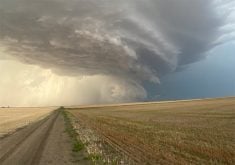July started off hot in Manitoba, but only the first two days had daytime highs above 30 C. After that, the province saw the development of a deep Hudson Bay upper low that meandered around for nearly two weeks, placing the eastern Prairies under a cool northerly flow.
That weather pattern broke in the last week of July and warm temperatures moved back in, but by then it was too late to make up for the cool start to the month.
Winnipeg was the province’s warm spot, with a mean monthly temperature of 17.9 C. In a strange reversal, however, the city was also the area furthest below its own long-term average. Winnipeg’s temperatures were 1.9 C below average.
Read Also

Agri-business and farms front and centre for Alberta’s Open Farm Days
Open Farm Days continues to enjoy success in its 14th year running, as Alberta farms and agri-businesses were showcased to increase awareness on how food gets to the dinner plate.
Rainfall in July came mostly from thunderstorms, with wide variation in amounts. Using three major urban centres, the Winnipeg region received about 65 millimetres, Brandon around 30 mm and Dauphin about 20 mm.
Winnipeg’s amount was slightly below average, while both Brandon and Dauphin came in well below average for the month.
Saskatchewan was a little warmer than Manitoba. Saskatoon reported a mean monthly temperature of 17.7 C and Regina came in at 18.2 C. Both readings were about 0.8 C below the long-term average for the month.
Both Regina and Saskatoon only saw about 20 mm of rainfall, compared to an average of around 65 mm.
Alberta was spared the impacts of the Hudson Bay upper low, which meant continued above-average temperatures like the region saw in June.
Edmonton was the hot spot, with a mean monthly temperature of 18.6 C (about 2.5 C above average). Calgary came in second at 18.2 C (1.7 C warmer than average) and the Peace River region was not far behind, with a mean monthly temperature of 17.6 C (1.3 C warmer than average).
Edmonton northward saw near to above-average rainfall in July. Both Edmonton and Peace River reported around 90 mm of rain, which was near average for Edmonton and about 20 mm above average for Peace River.
The southern half of the province was drier, with some regions seeing near average rainfall and others a little below average. Calgary reported around 40 mm of rain, which was about 20 mm below average.
The Old Farmer’s Almanac calls for average to slightly above-average temperatures over the rest of August, along with near average rainfall. September’s prediction is for average temperatures, but above-average rainfall.
The Canadian Farmer’s Almanac predicts average temperatures in August and calls for near average precipitation with a possible wet end to the month. September could see near to below-average temperatures. Its precipitation forecast also calls for above-average amounts.
As for the different weather model forecasts, NOAA appears to call for average temperatures from August through to October, with Alberta possibly seeing above-average temperatures. The precipitation forecast calls for an equal chance of either above- or below-average. There is a chance Alberta will see below-average precipitation.
The usually reliable Climate Forecast System model forecasts slightly below average temperatures for the rest of August, along with near- to above-average precipitation. Its September forecast is for near-average temperatures and above-average precipitation.
The Canadian CanSIP’s model forecasts above-average temperatures in the eastern and northern Prairies during the rest of August, with near-average temperatures and precipitation elsewhere. September’s forecast is for average temperatures and above-average precipitation.
I think we will see near-average temperatures in both August and September, and western regions have the best chance of continued above-average temperatures.
Daniel Bezte is a teacher by profession with a BA in geography, specializing in climatology, from the University of Winnipeg. He operates a computerized weather station near Birds Hill Park, Man. Contact him at daniel@bezte.ca.
















